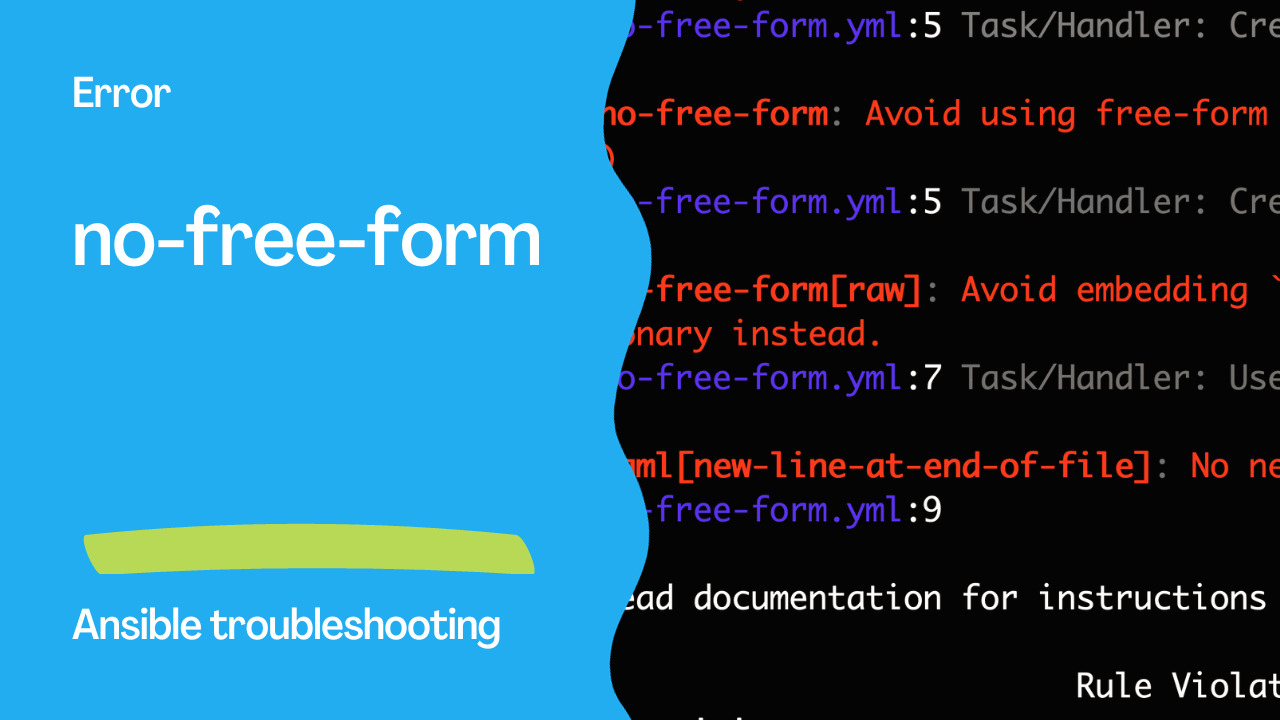Ansible Rule “no-free-form”: Shifting from Free-Form to Full Syntax
In the world of automation, precision and clarity are paramount. Ansible, the powerful automation tool, brings forth an array of features to make automation tasks simpler and more efficient. However, it also lays down specific rules to ensure the correctness and maintainability of your Ansible playbooks. One such rule is “no-free-form,” which enforces the use of full syntax over free-form syntax in module calling.
What Is Free-Form Syntax?
Free-form syntax, also known as inline or shorthand syntax, is a way to specify module parameters by simply listing them. While this might seem convenient, it can lead to subtle bugs and hinder the functionality of code editors and integrated development environments (IDEs) in providing feedback, autocompletion, and validation.
Here’s an example of problematic code with free-form syntax:
---
- name: Example with discouraged free-form syntax
hosts: all
tasks:
- name: Create a placeholder file
ansible.builtin.command: chdir=/tmp touch foo # <-- Using free-form
- name: Use raw to echo
ansible.builtin.raw: executable=/bin/bash echo foo # <-- Using executable=
changed_when: false
In this code, the use of free-form syntax in the ansible.builtin.command and ansible.builtin.raw modules can create issues and hinder the editing experience.
Output
WARNING Listing 4 violation(s) that are fatal
no-changed-when: Commands should not change things if nothing needs doing.
no-free-form.yml:5 Task/Handler: Create a placeholder file
no-free-form: Avoid using free-form when calling module actions. (ansible.builtin.command)
no-free-form.yml:5 Task/Handler: Create a placeholder file
no-free-form[raw]: Avoid embedding `executable=` inside raw calls, use explicit args dictionary instead.
no-free-form.yml:7 Task/Handler: Use raw to echo
yaml[new-line-at-end-of-file]: No new line character at the end of file
no-free-form.yml:9
Read documentation for instructions on how to ignore specific rule violations.
Rule Violation Summary
count tag profile rule associated tags
1 no-free-form basic syntax, risk
1 no-free-form[raw] basic syntax, risk
1 yaml[new-line-at-end-of-file] basic formatting, yaml
1 no-changed-when shared command-shell, idempotency
Failed: 4 failure(s), 0 warning(s) on 1 files. Last profile that met the validation criteria was 'min'.

Adhering to the Rule “no-free-form”
To adhere to “no-free-form,” it’s important to switch to the full syntax for module calling. Here’s the correct way to write the same code without using free-form syntax:
---
- name: Example that avoids free-form syntax
hosts: all
tasks:
- name: Create a placeholder file
ansible.builtin.command:
cmd: touch foo # <-- Using full syntax
chdir: /tmp
- name: Use raw to echo
ansible.builtin.raw: echo foo
args:
executable: /bin/bash # <-- Explicit and clear syntax
changed_when: false
In this corrected code, we’ve used the full syntax for the ansible.builtin.command and ansible.builtin.raw modules, making the code more readable and free from any free-form syntax issues.
The Importance of Full Syntax
The “no-free-form” rule promotes the use of full syntax over free-form syntax. Using full syntax ensures that your Ansible playbooks are clear, understandable, and free from subtle bugs. It also helps editors and IDEs provide better support for your Ansible code, enhancing your development experience.
Automatic Fixing
The good news is that this rule can be automatically fixed using the --fix option in ansible-lint. This makes it easier to transition from free-form to full syntax, ensuring that your playbooks adhere to Ansible’s best practices.
Conclusion
In conclusion, while free-form syntax might seem convenient, it can lead to issues and hinder the development process. By adhering to Ansible’s Rule “no-free-form” and embracing full syntax, you’ll ensure that your playbooks are precise, clear, and maintainable, making your automation tasks a breeze.
Subscribe to the YouTube channel, Medium, and Website, X (formerly Twitter) to not miss the next episode of the Ansible Pilot.Academy
Learn the Ansible automation technology with some real-life examples in my
Udemy 300+ Lessons Video Course.

My book Ansible By Examples: 200+ Automation Examples For Linux and Windows System Administrator and DevOps

Donate
Want to keep this project going? Please donate
